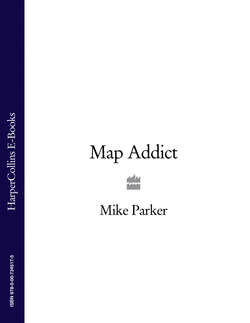Map Addict

Реклама. ООО «ЛитРес», ИНН: 7719571260.
Оглавление
Mike Parker. Map Addict
MAP. ADDICT. MIKE PARKER
Table of Contents
INTRODUCTION
1. TREASURE ISLAND
2. L’ENTENTE CARTIALE
3. EVERY NODULE AND BOBBLE
THE TOP FIVE 1:50 000 LANDRANGER MAPS
123 Llŷn Peninsula
131 Boston & Spalding
104 Leeds & Bradford
196 The Solent
34 Fort Augustus, Glen Roy & Glen Moriston
AND THE BOTTOM FIVE
11 Thurso & Dunbeath
176 West London / 177 East London
148 Presteigne & Hay-on-Wye
110 Sheffield & Huddersfield / 111 Sheffield & Doncaster
46 Coll & Tiree
4. BORDERLINE OBSESSION
5. THE POWER MAP
6. GOD IS IN THE DETAIL
7. CARTO EROTICA
8. BOYS’ TOYS?
9. PRATNAV
10. GOING OFF-MAP
BIBLIOGRAPHY
WEBSITES. MAP LIBRARIES AND RESOURCES
BLOGS AND DISCUSSION
INDEX
ACKNOWLEDGEMENTS
ABOUT THE AUTHOR
Copyright
About the Publisher
Отрывок из книги
A TALE OF OBSESSION, FUDGE & THE ORDNANCE SURVEY
At last.
.....
Both of my choices are beautiful works, but I love them mainly for being such remarkable snapshots of a very specific moment in time. They are graphic, lavishly detailed pictures of the world into which I was born at the tail end of 1966. No one knew it then, but they represent a world on the cusp of fundamental cataclysm. Our industrialised island, crammed full of mines and quarries and factories and railways, was shortly to become a post-industrial place of shopping centres, theme parks, light industrial estates and speedy roads. Nineteen-sixty six was the border between those two worlds, the year that saw both the last, gruesome gasp of the old order at Aberfan, and the sapling stirrings of our future economy, a leisure industry kick-started by the English victory in the football World Cup. It was the beginning of the era when the future ceased to be the national fetish, to be replaced, ultimately and ominously, by a slavish obsession with the past.
The battle between the future and the past raged through the late 1960s and the entire 1970s, through psychedelia, sexual liberation, student uprisings, strikes, power cuts and punk, but by the time the 1980s dawned, the past had won. Margaret Thatcher, the Grantham grocer’s daughter, invoked the Britain of a bygone age to anaesthetise us to everything, from small colonial wars to her battle to destroy organised labour. Nostalgia became a driving force of the economy: the backdrop to the breakneck changes that we choose to remember is ‘Ghost Town’ and Orgreave, but it could just as easily have been the multimillion selling Country Diary of an Edwardian Lady or the spin-off frills and frou-frou by the likes of Laura Ashley. The landscape, and hence maps, began to change too: town centres, the mercantile heart of the nation for over a thousand years, wilted in the heat of the new retail parks that were mushrooming alongside new bypasses and motorways. Heritage centres, heritage railways, industrial heritage, history denuded of its scandal and gore, erupted all over the country like a pox rash.
.....